________________
JANUARY, 1922]
THE APABHRAMGA STABAKAS OF RAMA-SARJAS
13
THE APABHRANSA STABAKAS OF RĀMA-ŠARMAN (TARKAVĀGTSA).
BY SIR GEORGE A. GRIERSON, K.C.I.E.
(With three plates.) THE welcome edition by Professor Jacobi of the Bhavisatta Kaha (Munich, 1910) has again drawn attention to the importance of Apabhramsa in the linguistic history of India. Its appearance has suggested to me the propriety of offering for publication a text and translation,-so far as I am capable of preparing either,--of the Apabhramsa sections of Rāma-sarman (Tarkavägisa)'s Prakrit grammar, known as the Präkrta-kalpataru. This exists, so far as is known, only in one MS. now in the India Office Library, which is very incorrect, and which can be read only with considerable difficulty and hesitation. I have been studying it for some time, and have, I hope, succeeded in restoring the text to something like what it was when it left its author's hands. The section dealing with the Vibhāsās partly appeared in the JRAS. for 1918. That dealing with Paiśäci will I hope soon appear in the Sir Ashutosh Mookherjee Commemoration Volume, and that dealing with Apa bhranía forms the subject of the present paper.
It is, I think, certain that there were two distinct schools of Prakrit philology in India. The first, or Eastern Schooll, was derived from Vararuci (himself an Easterner), and descended from him, through Laokêśvara and Kramadióvara, to Rāma-sarman and Märkandēya. The second, or Western School, is based on the so-called Vālmīki sūtras, now extant only in a much expanded form. From this teaching are descended tho grammar of Hēmacandra, who used a technical terminology of his own, and the works of Trivikrama, Lakşmidhara, Simharāja, and others, who followed the whole system of terminology found in the expanded Valmiki sūtras. Even when dealing with standard Prakrit the two schools not unoften contradict or supplement each other, but their main difference consists in their respective treatments of the Vibhāşūs, of Apabhramsa, and of Paišācī. For instance, the Paisāci described by Vararuci and his successors, who in their accounts actually give a quotation from the Brhatkathā, is not the same language as that described by Hēmacandra and Trivikrama? It is unnecessary to go into further detail on this point. I mention it here merely to show the importance of Rüma-sarman's work.
The Prakrta-kalpataru, or. Wishing-tree of Prakrit', is, according to its author, based on the Präkrta-kāmadhēnu of Laikêśvara, a work described by Rajendra-lüla Mitra in Nos. 3157 and 3158 of Vol. IX of his Notices of Sanskrit MSS., but which has since, to my great regret, disappeared. The Kalpataru is divided into three Sakhas, or Branches.' Each Sakhā is divided into so many Stabakas or Clusters,' and each Stabaka into so many Kusumas or Flowers, each consisting of a single verse, with, in the earlier Sākhās, a full prose commentary. The first Sakhā deals with Mahārāştri Prakrit, in nine Stabakas. The second Sakha (three Stabakas) deals with Sauragēni, Māgadhi, and their sub-dialects. and the third describes (1) the Vibhāṣās (one Stabaka), Apabhramsa (two Stabakas), and
1 It is a mistake to suppose that Prakrit was not employed for literature in Eastern India. As oXamples of Apabhrama I may quote the Kirti-latā, a historical work by the famous Vidyāpati Thakur of Mithila, and the Döha-kona of the Bengali Kroyacaryapida.
3 The only writer referred to by both schools as authoritative is Bhämaha, who was a Kashmiri and belonged to neither.
3 I would draw the attention of Indian scholars, especially those of Bengal, to the importance of this work, and to the urgent need of a further senrch being made for it. I have dono all that I could by correspondence, but have failed.




